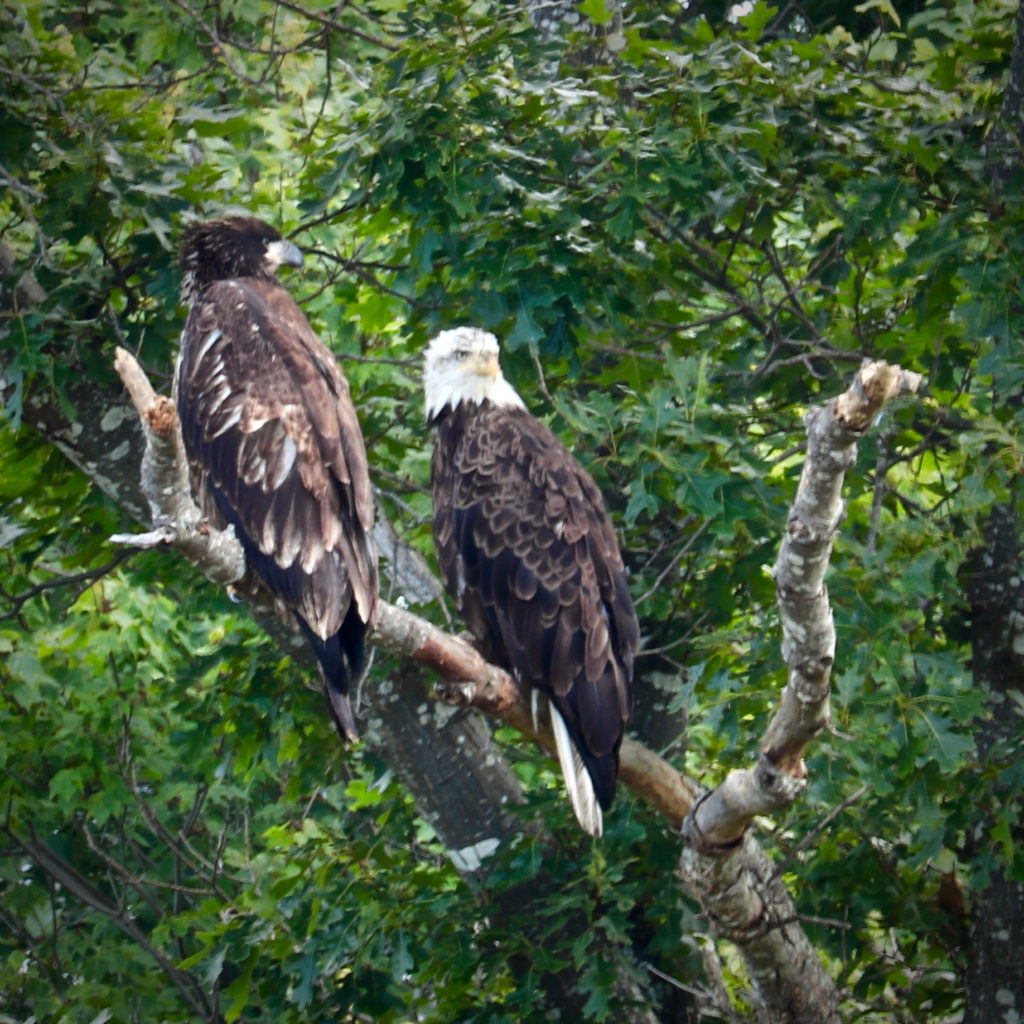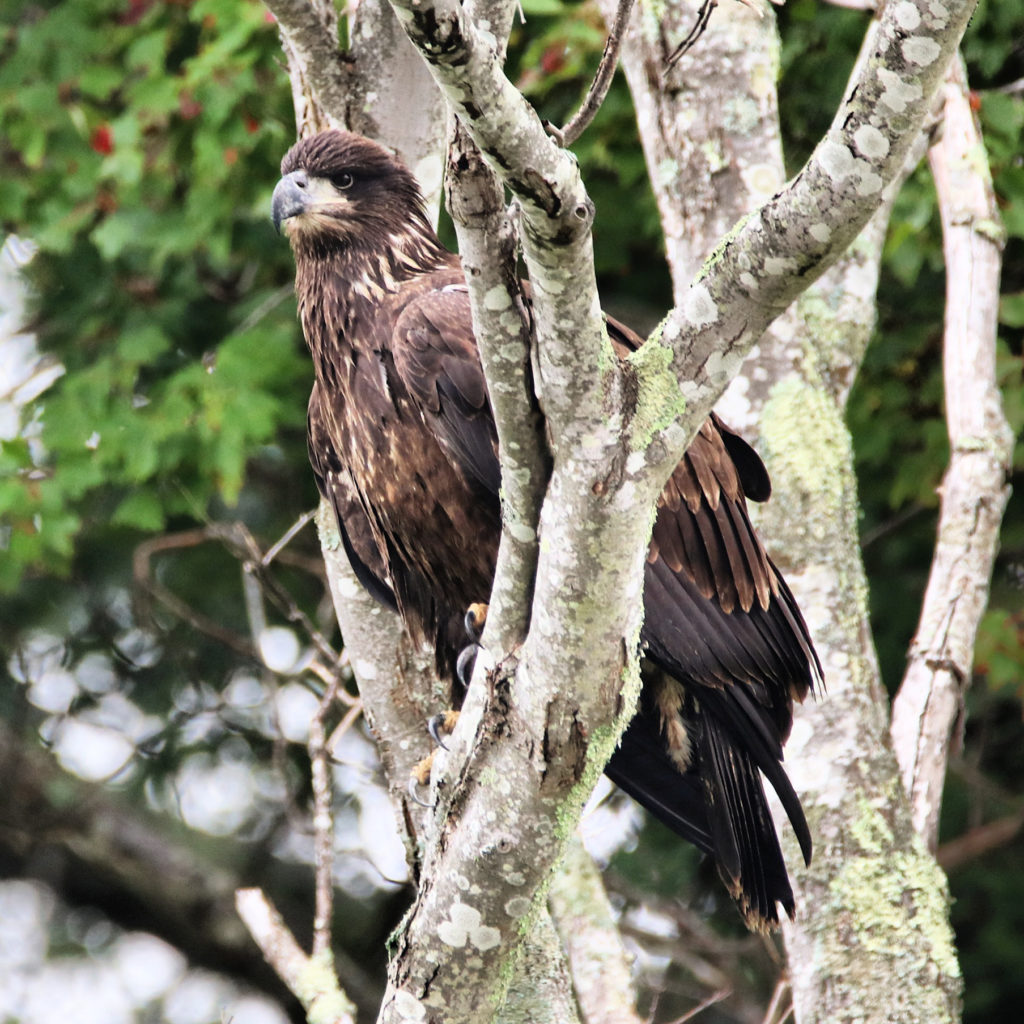NATURE
by Kezia Bacon, Correspondent

Have you heard about the bald eagles that are nesting on the North River? Have you seen them?
For the past century, to observe a bald eagle in the wild would be a rare occurrence. To see one on the South Shore — inconceivable! But thanks to repopulation efforts, the once endangered species is now making a comeback across Massachusetts.
The bald eagle is widely recognized as a symbol of the United States. In fact, since 1782, it has been considered our national emblem, appearing on coins, the presidential flag, and the country’s Great Seal. While not technically bald, the eagle’s head is white, standing out distinctly from its bright yellow bill and legs, and the darkly colored feathers of its body.
The bald eagle is one of the largest birds in North America. It weighs 6 to 13 pounds, and measures two to three feet in height, with a wingspan extending an average of six feet across. Its size makes it easy to spot!
Bald eagles make their homes in forested areas, near large bodies of water. Proximity to the ocean, a lake or reservoir, or a marsh or river, is important, as is the relative lack of development in the area. Bald eagles will tolerate human activity, especially near food sources, but they prefer to nest in more isolated spots. Probably the best places to observe them are food related: when they are perched in tall trees on the lookout for their next meal, or when they’re flying over the water in search of fish. In addition to fish such as herring and shad, our local eagles are known to dine on an array of smaller species — seabirds, crabs, rabbits, reptiles — both alive and as carrion. Bald eagles are notorious for stealing captured (or killed) prey from other creatures.
Bald eagles build their nests just below the crowns of trees — up high, and close to the trunk. Their nests are quite large — five or six feet wide and 2-4 feet deep. That’s big! Sticks are the primary building material, followed by grass, moss and other vegetable matter, which helps not only to fill in the gaps, but to provide a soft lining.

So why isn’t it common for us to see bald eagles here on the South Shore? Very likely, it used to be — more than 100 years ago. The first negative impact was the destruction of their habitat. As the region became more developed, the eagles fled. Even more influential was the widespread use of the pesticide DDT. Throughout the latter half of the 20th century, bald eagle populations across North America went into a steep decline. Why? Because DDT depleted the calcium in the eagle’s metabolism, which in turn softened the shells of the eggs it laid, making them significantly less viable. The result was catastrophic. Breeding essentially ceased. Fortunately, the use of DDT was banned in 1972. A decade later, Mass Audubon and the state Division of Fisheries and Wildlife joined forces to restore the bald eagle population in Massachusetts.
From 1982 to 1988, young bald eagles were brought — from Michigan, Manitoba and Nova Scotia — to a protected area at the Quabbin Reservoir in Central Massachusetts, where they were nurtured and eventually released into the wild. These efforts proved successful. In 1989, the first offspring from those eagles hatched, fledged, and matured. Slowly but surely the bald eagle population in Massachusetts began to grow. By 2012, there were 38 breeding pairs, with nests reported not only at the Quabbin, but also along the Connecticut and Merrimack Rivers, at Arcadia Wildlife Sanctuary in Easthampton, and at some of Plymouth’s ponds. Nationwide, bald eagles are now considered “threatened” which is considered one level safer than “endangered.”
Until recently, one would never expect to see a bald eagle within the watershed of the North and South Rivers. But today it’s quite common. The early morning hours, when eagles tend to do the bulk of their hunting, seem to be an optimal time for eagle viewing. Odds increase in the winter months. You may spy an eagle in flight, which is a sight to behold! If you happen to spot a nest, please keep a respectful distance.
Bald eagles have been spotted at the sites listed below. Good luck!
- Damons Point, Marshfield. https://www.nsrwa.org/listing/damons-point/
- Route 3A Bridge, Marshfield and Scituate. https://www.nsrwa.org/listing/route-3a-bridge/
- Mass Audubon’s North River Sanctuary, Marshfield https://www.nsrwa.org/listing/north-river-wildlife-sanctuary/
- Couch Beach, https://www.nsrwa.org/listing/couch-beach/
- Driftway Conservation Park, Scituate https://www.nsrwa.org/listing/driftway-conservation-park/
- Also, our North River Pontoon Boat Tours offer the opportunity to see some amazing wildlife, such as bald eagles and osprey. Check out the variety of pontoon tours at https://www.nsrwa.org/events/
Sources:
- https://www.massaudubon.org/learn/nature-wildlife/birds/bald-eagles/eagles-in-massachusetts
- https://www.wbur.org/news/2018/02/16/bald-eagle-population-soaring
- https://959watd.com/blog/2017/04/ma-bald-eagles-thrive-on-south-shore/
- https://www.allaboutbirds.org/guide/Bald_Eagle/overview
Kezia Bacon’s articles appear courtesy of the North and South Rivers Watershed Association, a local non-profit organization devoted to protecting our waters. For membership information and a copy of their latest newsletter, contact NSRWA at (781) 659-8168 or visit www.nsrwa.org. You will also find 20+ years of Kezia’s Nature columns there.
